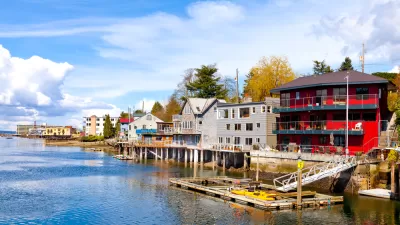Few housing markets serve as a better case study about the politics and effects of housing supply than Seattle. A local writer takes a deeper look at the city's total development over the past year and comes to some surprising conclusions.
Ethan Phelps-Goodman takes a look back at the development year that transpired in Seattle, finding that appearances don't tell the whole story. According to Phelps-Goodman, that is, all those construction cranes dotting the city skyline don't mean that 2015 was a pace-setting year for construction: "housing production is actually set to decline this year as compared to the year before."
More specifically:
"Extrapolating from numbers published by the City of Seattle for the first three quarters of 2015, housing production for this year will be about 6,800 units (although an end of the year surge is certainly possible). That’s about equal to 2013 levels, but off significantly from the 8,300 units produced in 2014."
Phelps-Goodman notes that the city's development environment suffers from a problem of perception. So while production of single-family homes, townhouses, and small apartments increased more than 20 percent, construction of midrise buildings dropped from 3,800 units to a projected 2,700 units this year. Phelps-Goodman also notes that the perception problem is also a question of location, with neighborhoods like Capitol Hill, First Hill, the U-District, and Columbia City adding lots of units, while South Lake Union, Northgate, Queen Anne, Ballard, Green Lake, and Roosevelt had a "paucity" of projects.
It's also worth noting that the city data cited by Phelps-Goodman produces a narrative that contradicts a story pushed in November, in which landlords lamented a "tsunami" of rental units coming online in the region over the past several years, slowing the growth of media rents.
FULL STORY: Despite perceptions, housing production down in 2015, single family home construction up

Alabama: Trump Terminates Settlements for Black Communities Harmed By Raw Sewage
Trump deemed the landmark civil rights agreement “illegal DEI and environmental justice policy.”

Planetizen Federal Action Tracker
A weekly monitor of how Trump’s orders and actions are impacting planners and planning in America.

The 120 Year Old Tiny Home Villages That Sheltered San Francisco’s Earthquake Refugees
More than a century ago, San Francisco mobilized to house thousands of residents displaced by the 1906 earthquake. Could their strategy offer a model for the present?

Ken Jennings Launches Transit Web Series
The Jeopardy champ wants you to ride public transit.

BLM To Rescind Public Lands Rule
The change will downgrade conservation, once again putting federal land at risk for mining and other extractive uses.

Indy Neighborhood Group Builds Temporary Multi-Use Path
Community members, aided in part by funding from the city, repurposed a vehicle lane to create a protected bike and pedestrian path for the summer season.
Urban Design for Planners 1: Software Tools
This six-course series explores essential urban design concepts using open source software and equips planners with the tools they need to participate fully in the urban design process.
Planning for Universal Design
Learn the tools for implementing Universal Design in planning regulations.
Clanton & Associates, Inc.
Jessamine County Fiscal Court
Institute for Housing and Urban Development Studies (IHS)
City of Grandview
Harvard GSD Executive Education
Toledo-Lucas County Plan Commissions
Salt Lake City
NYU Wagner Graduate School of Public Service





























